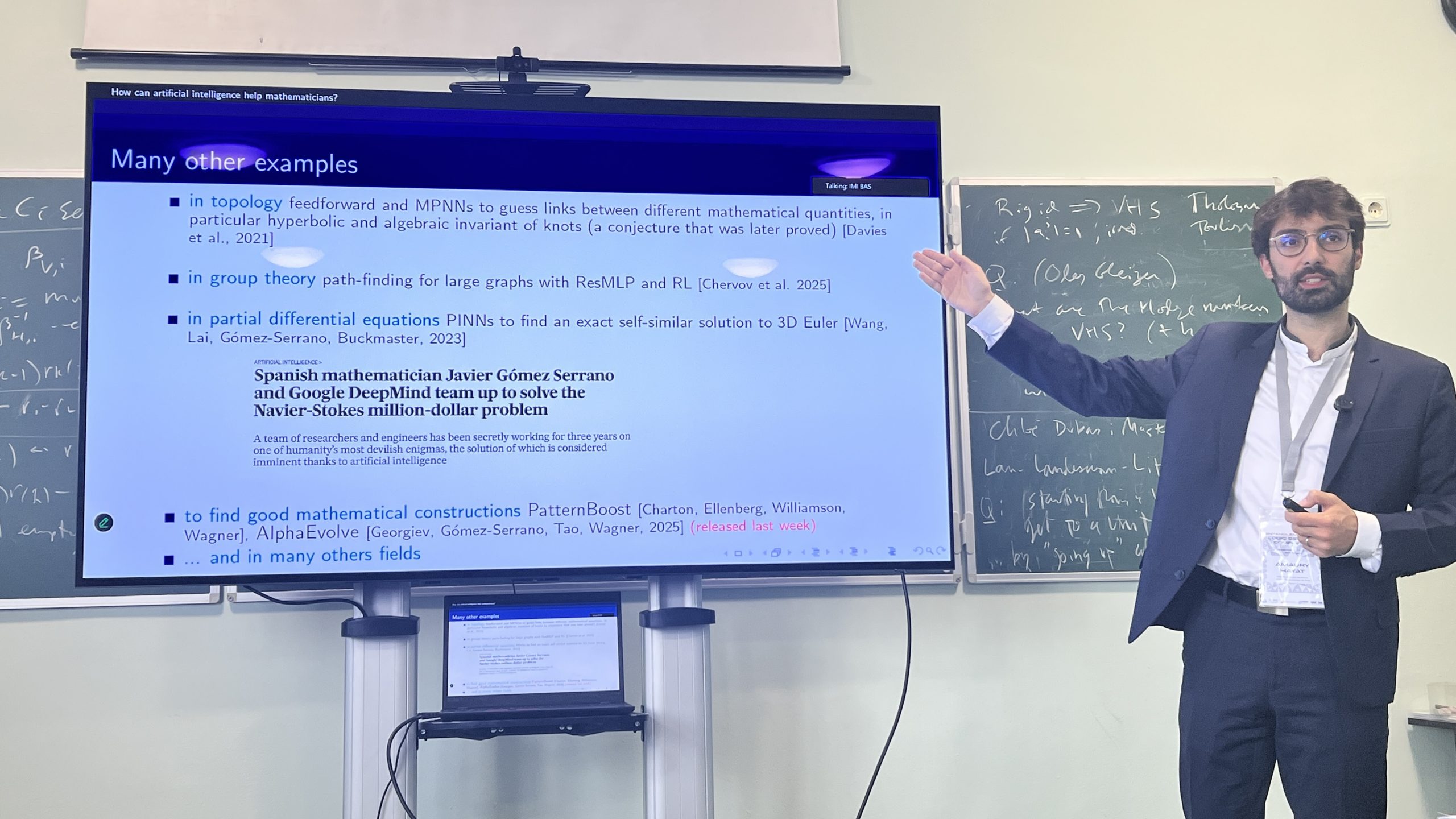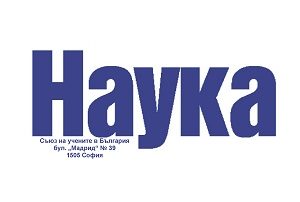Forthcoming events
News
IMI Mathematics Prize for 2026 Nominations
 The Institute of Mathematics and Informatics (IMI) at the Bulgarian Academy of Sciences opens a call for nominations for the IMI Mathematics Prize for the year 2026 for excellent achievements in Mathematics. The candidates must be Bulgarian citizens and must not have completed 40 years of age before January 1st, 2026.
The Institute of Mathematics and Informatics (IMI) at the Bulgarian Academy of Sciences opens a call for nominations for the IMI Mathematics Prize for the year 2026 for excellent achievements in Mathematics. The candidates must be Bulgarian citizens and must not have completed 40 years of age before January 1st, 2026.
The IMI award is a metal statuette, accompanied by a diploma and a cash prize. Funds for the premium are raised through donations. Details about the Prize and the nomination procedure can be found in the Statute of the Prize.
The members of the IMI Prize Committee for 2026 are:
- Julian Revalski, Director of the International Center for Mathematical Sciences–Sofia at the Institute of Mathematics and Informatics at the Bulgarian Academy of Sciences, Bulgaria – Chairman of the Prize Committee
- Jean-Pierre Bourguignon, Institut des Hautes Etudes Scientifiques, France
- Jaqueline Mesquita, University of Campinas, Brazil
- Nikolai Nikolov, Institute of Mathematics and Informatics, Sofia, Bulgaria
- Yuri Tschinkel, Courant Institute, USA, Foreign member of the Bulgarian Academy of Sciences
The deadline for nominations is May 8th, 2026. Nominations should be sent via e-mail to the Chairman of the Prize Committee at revalski@math.bas.bg.
Nominations must include the following:
- Name, date of birth and affiliation of the nominee;
- A brief description of the nominee’s most significant contributions presented in language comprehensible to mathematicians from various fields;
- List of most significant selected works (no more than 10).
For the first time, the Prize was awarded in 2014 to Martin Kassabov, a Professor at Cornell University, USA. In 2017, during the International Conference Mathematics Days in Sofia, the prestigious award was presented to Kiril Dachev, professor of mathematics at Purdue University, USA. The first woman recipient of the IMI Award is Greta Panova, associate professor at the University of Southern California, USA, who received the award in 2020. The 2023 IMI Prize was awarded to Vesselin Dimitrov, Georgia Institute of Technology, USA, and was presented to him on July 10, 2023, during the opening of the International Conference Mathematics Days in Sofia, personally by the President of the Republic of Bulgaria Rumen Radev, under whose patronage the conference is being held.
The winner of the IMI Mathematics Prize for the year 2026 for excellent achievements in Mathematics will be announced and presented on July 6, 2026, at the official opening of the International Conference Mathematics Days in Sofia 2026.
More about the laureates read here.
Merry Christmas! Happy New Year!
The Management of the Institute of Mathematics and Informatics at the Bulgarian Academy of Sciences
extends its warm greetings to colleagues, partners, and friends on the occasion of the upcoming Christmas and New Year holidays.
At the close of another dynamic and productive year, we express our sincere gratitude for the trust,
cooperation, and shared dedication to promoting science, education, and the progress of mathematics and informatics.
We wish you bright holidays filled with health and peace, and may the New Year bring inspiration, new ideas, and meaningful achievements!
IMI-BAS and ICMS-Sofia Launched the Atanasoff Memorial Lecture Series Celebrating John Vincent Atanasoff
On November 10, 2025, the Institute of Mathematics and Informatics of the Bulgarian Academy of Sciences hostеd the event Atanasoff Memorial Day – a new initiative of the Institute of Mathematics and Informatics at the Bulgarian Academy of Sciences and the International Center for Mathematical Sciences (ICMS-Sofia) at IMI-BAS.
The organizers’ ambition is to hold the Atanasoff Memorial Lecture Series every year, thus commemorating the life of John Vincent Atanasoff (1903–1995) – a computer pioneer, inventor of a model of an electronic digital computer and renowned as the “Bulgarian father of the electronic computer”. It aims to celebrate the intersection between mathematics, computation, and the sciences of complexity — the very domains that unite topology, geometry, and machine learning in the 21st century.
Each year, an internationally distinguished scientist is invited as the Atanasoff Lecturer to deliver a keynote lecture highlighting frontier ideas where mathematical structure meets computational innovation. The series provides an open platform for dialogue across fields: pure mathematics, physics, data science, and artificial intelligence. It also serves as a tribute to the scientific imagination of John Vincent Atanasoff, whose work laid the foundations of electronic computation.
The inaugural edition of the series took place at the International Center for Mathematical Sciences (ICMS-Sofia) at IMI-BAS, on November 10, 2025. The program includes topics from topology to machine learning, control, and data-driven modelling of complex systems.
This year, the keynote lecturer was Amaury Hayat, French mathematician and applied scientist, Professor at École des Ponts–Institut Polytechnique de Paris, working on control and stabilization of PDEs and on applications of artificial intelligence to mathematics.
Among other distinguished mathematicians who attended the first Atanasoff Memorial Day were:
- Raphaël Douady, French mathematician and economist, PhD (1982, Paris VII) in Hamiltonian dynamics, former Frey Chair of Quantitative Finance at Stony Brook (SUNY) and Academic Director at LabEx ReFi, Co-founder and Research Director of Riskdata, with decades of work in chaos theory, systemic-risk modelling, polymodel theory and machine-learning methods in finance.
- Carlos Simpson, American algebraic geometer, PhD form Harvard (1987) under Wilfried Schmid on Systems of Hodge Bundles and Uniformization, Research Director at CNRS, Université Côte d’Azur. His work includes non-abelian Hodge theory, higher categories, moduli spaces and computer-aided proof verification.
- Yuri Tschinkel, Russian-German-American algebraic geometer, PhD from MIT (1992), Junior Fellow at Harvard Society of Fellows, Gauss Chair at Göttingen, Chair at Courant (NYU), and Director at the Simons Foundation. His research is in the field of rational points, birational geometry and the arithmetic of high-dimensional varieties.
- Phillip A. Griffiths, American mathematician, Institute for Advanced Study (IAS Princeton). Renowned for foundational work in Hodge theory, algebraic geometry and differential geometry, as well as for his leadership in shaping modern mathematical institutions and research communities. For his outstanding contributions to the development of modern mathematics, for his exceptional role in fostering international collaborations with IMI–BAS, and for his efforts in strengthening the Institute’s position as a leading international research centre, in 2025 Prof. Griffiths was awarded the Medal with Ribbon of IMI–BAS.
Prof. Phillip Griffiths was Awarded the Medal with Ribbon of IMI–BAS
 According to a decision of the Scientific Council of the Institute of Mathematics and Informatics at the Bulgarian Academy of Sciences (IMI–BAS), taken on July 11, 2025, the Medal with Ribbon of IMI–BAS was awarded to Prof. Phillip Griffiths, Institute for Advanced Studies, USA.
According to a decision of the Scientific Council of the Institute of Mathematics and Informatics at the Bulgarian Academy of Sciences (IMI–BAS), taken on July 11, 2025, the Medal with Ribbon of IMI–BAS was awarded to Prof. Phillip Griffiths, Institute for Advanced Studies, USA.
The distinction is conferred for his outstanding contributions to the development of modern mathematics, for his exceptional role in fostering international collaborations with IMI–BAS, and for his great efforts in establishing the Institute’s position as a leading international research center.
The medal was presented online by Prof. Velichka Milousheva, Deputy Director of IMI–BAS and of the International Center for Mathematical Sciences (ICMS–Sofia).
Prof. Phillip Griffiths is one of the most influential mathematicians of the last half-century with fundamental contributions that have reshaped modern geometry. Renowned for his work in algebraic and differential geometry, Griffiths has made groundbreaking advances in areas ranging from Hodge theory to partial differential equations. His ideas and results have not only solved long-standing problems but also opened entirely new avenues of research.
In recognition of his profound impact, he has received numerous honors, including Chern Medal (2014), Steele Prize (2014), Wolf Prize in Mathematics (2008), and he is a member of the U.S. National Academy of Sciences, the Russian Academy of Sciences and the Indian Academy of Sciences.
IMI will present three innovative projects at the International Forum “Advanced ICT Research and Innovation”
 From September 29 to October 1, 2025, the Council on Science and Innovation in Information and Communication Technologies and the Bulgarian Academy of Sciences are organizing the International Forum “Advanced ICT Research and Innovation.” The event is held under Investment C2.I2 “Enhancing the Innovation Capacity of BAS in the Field of Green and Digital Technologies,” part of the National Recovery and Resilience Plan.
From September 29 to October 1, 2025, the Council on Science and Innovation in Information and Communication Technologies and the Bulgarian Academy of Sciences are organizing the International Forum “Advanced ICT Research and Innovation.” The event is held under Investment C2.I2 “Enhancing the Innovation Capacity of BAS in the Field of Green and Digital Technologies,” part of the National Recovery and Resilience Plan.
The Institute of Mathematics and Informatics at the Bulgarian Academy of Sciences will take an active part in the forum, presenting three projects funded under the Recovery and Resilience Mechanism:
- “Innovative Software Platform for Serious Educational Games with Creative Visualization for Building Competence and Responsible Management of Natural Resources – ProNature” with a team leader Assoc. Prof. Detelin Luchev, PhD (Department of Mathematical Linguistics);
- “Integrated Framework for Health Service Improvement via Analysis of Patient Reported Outcomes Data” with a team leader Assoc. Prof. Krasimira Ivanova, PhD (Department of Software Technologies and Information Systems), and
- “Models, Methods and Tools for Predicting the Technical and Perceived Quality of Service in Cyber-Physical Social Systems” led by Prof. Ivan Ganchev, PhD (Department of Information Modelling).
The forum will present scientific research and innovations with practical applications and technology transfer. Its aim is to foster cooperation between academia, industry, and the startup ecosystem, encouraging transformation towards sustainable and digital solutions. The event will provide a platform for exchanging ideas, presenting results, and building new partnerships in the field of green and digital technologies.
Key topics include:
- ICT for new and energy-efficient technologies;
- ICT in industry;
- Modelling, simulation, and digital twins in industry and energy;
- Internet technologies and services. Internet of Things (IoT);
- Big data/linked data and geospatial data – Data analysis, data processing/management, data mining; knowledge discovery; machine learning; prediction models;
- ICT in medicine, healthcare, and sports;
- ICT in creative and recreational industries. Rapid prototyping, 3D digitization, and visualization.
The program runs from September 29 to October 1, 2025, at Sofia Tech Park, The Venue Hall, ground floor of the Incubator building.
Registration form can be found here: https://docs.google.com/forms/d/e/1FAIpQLScC6v7V-a_TeoTEVHBT5lhwRJj-4yqg4d0JYNejJbOiPdKAeg/viewform?usp=header
Administration
IMI PRIZE
IMI MATHEMATICS PRIZE
Please donate

































